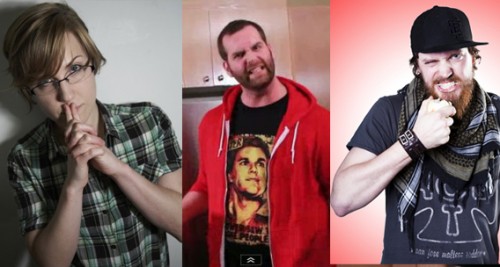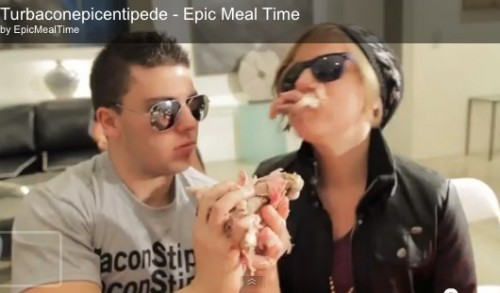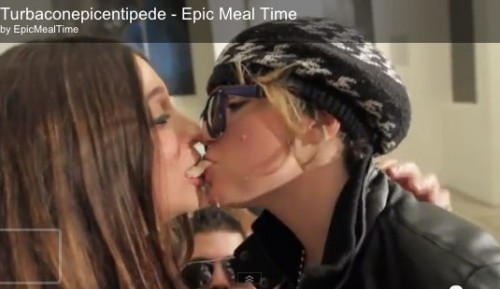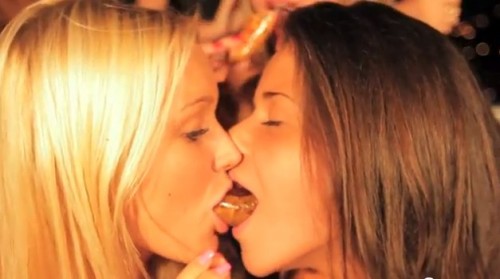
Since you are probably going to spend today arguing about Occupy Wall Street with your conservative family members and helping your parents with computer questions we figured you would appreciate some slightly ligher fare: internet cooking shows. But because we are social scientists, we can’t be satisfied with uncritical review. Therefore, I want to discuss how these cooking shows interact with, perform, reify, and probelmitize constructions of gender and nationality. The three shows I want to cover (I’m gonna have to pass on this and this. There’s a great article at dailydot.com that lists most internet cooking shows.) are Epic Meal Time, Regular Ordinary Swedish Meal Time, and My Drunk Kitchen. Full disclosure: I have a profound weakness for all of these shows, with increasing affinity in the order I just presented them. In case you’re unfamiliar with these shows, I’ll briefly introduce them and then get into the theory. [Images after the break might be considered NSFW.]
Epic Meal Time
Epic Meal Time (EMT) could easily be written off as an apolitical, sexist, hyper-masculine, food porn extravaganza that is totally unapologetic in its ravenous desire to prepare pork products doused in brown sugar and Jack Daniels in new and creative ways. Such dismissal would be easily defensible and generally correct. They keep a calorie counter in the bottom right corner of the screen, and their latest creation –The Turbaconepicentipede– clocks in at a truly epic 802,420 calories. Their videos get millions of hits and their twitter channel rivals Justin Bieber’s.
Ordinary Regular Swedish Meal Time
A parody of Epic Meal Time, Regular Ordinary Swedish Meal Time (ROSMT) features several young Swedish men yelling at each other while they cook relatively boring dishes. ROSMT is meant to show that even the most ordinary dish, Swedish meatballs, for example, is epic in and of itself. They throw the ingredients around, yell in a virtually incomprehensible mix of English and Swedish called “Swenglish”, and commit minor acts of physical assault on one-another. There are also semi-regular appearances by a mischievous fox called Mr. Fox. Niclas, the host, is very fond of mayonaise as a “pre-dinner snack.”
My Drunk Kitchen
My Drunk Kitchen (MDK) is less about cooking, and more about being a cooking show. Despite its meteoric rise in popularity, each show is still filmed on a web cam pointed toward an oven. The host and creator, Hanna “Harto” Hart, plays with this defined frame by constantly making reference to things happening off camera, making subtle reference to backwards letters (web cams record a “mirror” image), and popping in and out of frame to make witty quips or drunkly slur a (charming) self-deprecating remark. She gets progressively more drunk as the show goes on and her final food product is only barely edible (If she makes anything at all).
Gender and Culture in Internet Cooking Shows
EMT, ROSMT, and MDK are all do-it-yourself affairs that rely heavily on their creators/stars to make the shows entertaining and unique. These shows are personal and are built upon the personalities of their creators. Each show seems more like a person than a media entity. EMT is your embarrassing sexist-even-though-he-knows-better college frat friend; ROSMT is not willing to make the sexist jokes, but wants you to be equally impressed by his antics and instead makes self-deprecating jokes about his ethnicity; and MDK is your best friend that puts up with the antics of your first two friends and will gladly party with them anyway.
ROSMT trades on images of vikings, black metal, and harsh climates, to enact a very particular kind of masculinity. The show is funny, because these things are taken to their extremes while also acknowledge the bland and uninteresting foods commonly eaten by Swedes. The “epic” nature of Swedish culture makes up for the less-than-epic food.
EMT has quickly become offensive in its transparent objectification of women. Bitch Magazine’s Jessica Critcher writes,
Though the show regularly features guest eaters, female ones are present only when the day’s dish is appropriately sexualized: In one episode, a giant dessert crepe is eaten, hands-free, by two young women who are filmed from angles best described as “blowjob-esque.”
Harto is an openly gay woman that frequently shows support for LGBT rights and puts up with some strongly heteronormative redditers, but still makes a point to appear on shows that regularly talk about and treat women like objects. This might be more an effect of internet video being a “boys club” than anything else. Breaking the glass ceiling may require amicable relationships with EMT and other shows that aren’t even food related. This doesn’t mean she silently plays along though. After she stated that one of her “pet peeves” was men claiming they can drink anyone under the table, the men at Revision3 decided to challenge her to beer pong.
Like I said earlier, these shows are inseparable from the personalities of their hosts and creators, so it is hard to figure out how these people actually feel about each other. Harley Morenstein of EMT says he loves and has been in constant contact with the ROSMT guys and Harto called the EMT guys “nice young gentlemen.” Beyond that, however, I can only guess at the intentional and personal relationships between Harto, Harley, and Niclas. But as a social scientist, I can look at the media artifacts and what they convey.
Gender representations become problematic in EMT’s lastest episode in which Harto joins Harley and the gang in devouring the “Turbaconepicentipede”. At first, she is presented as an equal to the EMT crew, devouring the feast as a peer:
But only a few seconds later, Harto is filmed eating a long piece of meat with another woman, until their lips touch:
We can interpret this multiple ways. First, we can position Harto in the masculine role, and the image is similar to the (nonhuman) heterosexual romance depicted in “Lady and the Tramp”. In another interpretation, we can see this as two women eating a phallic food product under the male gaze. This has been used in EMT in such episodes as “Sausage Fest”:
Still there is a third interpretation, and one that I like better than the former two. Harto is fully participating in EMT in a role that simultaneously masculine and feminine. She is participating in the male fantasy of two desirable/desiring women engaged in an act of (assumed) mutual arousal. At the same time, as a subject, she is a homosexual woman engaging in an intimate act with someone of the same sex. In a thoroughly Heideggerian sense, the technology of the video -and the people it captures as subject and object- are in a state of emergence. If you view the episode knowing that Harto is a lesbian, then we might see her in the masculine mode, if we do not know her sexual orientation, we might see her in the same light as those women in “the sausage party.” This is the power of the video: both as a technology and as a cultural object, it produces its own meaning independent of its constituent parts. We should also note this is happening within the rich cultural milieu of western holidays, food culture, bodies, intoxication, heteronormativity, and sexuality. Women are expected to remain sexualized, yet humble, are expected to prepare food and engage in festive eating, while also maintaining certain body types. It is a complicated set of factors that leave me with more questions than answers. Perhaps, just as Harto rarely completes her dish, I can leave this discussion incomplete, half-baked, and just appreciate the process.
Many thanks to Britney S.G., Dan Lyles, and K. Mcauley for their help in various parts of this post.
You can follow David on twitter: @da_banks




Comments 7
jk — November 25, 2011
"In a thoroughly Heideggerian sense, the technology of the video -and the people it captures as subject and object- are in a state of emergence. If you view the episode knowing that Harto is a lesbian, then we might see her in the masculine mode, if we do not know her sexual orientation, we might see her in the same light as those women in “the sausage party.” This is the power of the video: both as a technology and as a cultural object, it produces its own meaning independent of its constituent parts."
Could you expand more on what you mean here? I am failing to see how the video "produces its own meaning independent of its constituent parts", as you've outlined here, since it seems that either Harto is a masculine lesbian or a puppet for male desire.
Cyborgology Weekly Roundup » Cyborgology — November 27, 2011
[...] David Banks gets into the Thanksgiving spirit and discusses sexism and Internet food videos [...]
Chuck — November 28, 2011
I suspect you've used the term "post-modern" in reference to things other than architecture.
Hart's "Lady and the Tramp" moment was a fair bit different than the sausage party clip. I shouldn't even need to explain why, but apparently you take great liberties in what you proclaim to be a "phallic object". Does ramen qualify as phallic? How about cheese? I'd hate to know how a chunk of turkey appears phallic to you.
"This might be more an effect of internet video being a “boys club” than anything else. Breaking the glass ceiling may require amicable relationships with EMT and other shows that aren’t even food related" Seriously? Hart (the 'o' is part of her user name, not her last name, and you could at least bother to learn that much about her before you claim her as an object, though I do love irony) came to my attention independent of epic meal time, and you're going to have to qualify exactly why this was anything other than a collab, something EMT do often. As for your glass ceiling (I think feminists look for these sometimes) lets not forget the gender of the first youtube celebrity, and that gender parity amongst popular youtubers is pretty neck and neck. Your opinion is great, but you've simply assumed the "boys club" part. You can't just assume it exists everywhere, even if your argument is weak without this assumption. Nice try, though.
Perhaps it didn't occur to you that maybe EMT are simply fans of Harts vids. Of course, that would be too simple, and make for boring reading.
Finally, if this is the discussion which is prompted by a video in which 10 pigs are stuffed with 50 birds, sewn anus-to-mouth, and messily devoured, presumably with each participant leaving with a hefty bag full of leftovers, then I shake my head.
The level of wank is such that I feel as though I've spent the last hour on chatroulette.com. I'm sure you were pleased with yourself when you finished proofreading it.
We Have Never Been Actor Network Theorists » Cyborgology — December 15, 2011
[...] Paul Strohecker’s posts on prosthetics and depictions of disability in the media. My work in gender and online cooking shows, mobile information systems in the developing world, augmented warfare, and the changing landscape [...]
kevin — December 27, 2011
nice article